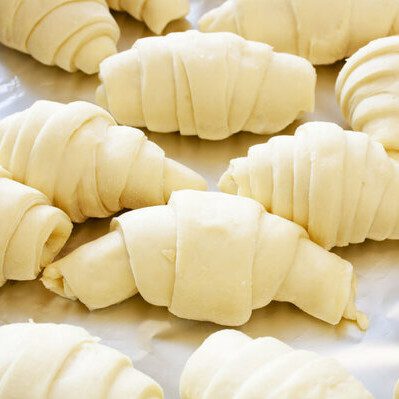
Par-baked Dough
Also known as partially baked dough
What is Par-baked Dough?
Par-baked dough is a dough that is partially baked. It can be stored frozen or at room temperature under a modified atmosphere to prolong its shelf life for future consumption. Par-baked products are baked to the point of crumb setting and oven spring but not to develop Maillard browning.1
Par-baked products can be:2
- Partially baked unfrozen: baked until crust coloration starts to form, and immediately packaged in a modified atmosphere packaging (MAP) and stored at room temperature.
- Partially baked frozen: immediately frozen and stored under freezing conditions.
Origin
Par-baked dough was first produced in the US in the 1950s and later introduced to Europe in the 1970s. Advances in freezing technology in the 1980s were essential for the successful commercialization of these types of products.1
Nutrition
Nutritional value of par-baked commercial bread per 100 grams:3
Commercial production
Par-baked doughs are manufactured using the following process:2,4
- Weighing and mixing: ingredients such as flour, salt, yeast, sugar are weighed and placed in a mixer (batch or continuous) and thoroughly combined.
- Fermentation: the dough is fermented for a short period of time, between 10 – 15 minutes.
- Make-up: dough balls are formed and placed in the appropriate baking pans.
- Proofing: the round balls are left to proof for 28 – 30 minutes in canvas-covered cups at 45 -55 oC (113 – 131 oF) and a relative humidity of 50 – 55%.
- Depositing: the proofed dough is deposited onto a hot baking surface to expand in the retainer.
- Baking: the dough is baked in a conventional oven at lower baking temperatures than typically used for fully baking. The dough must reach ideally a temperature of 76 – 86 oC (170 – 190 oF).
- Cooling: dough is cooled to room temperature for further packaging.
- Storage: can be stored under specified conditions either at room temperature or at freezing temperatures depending on desired usage.
Application
Considerations are critical for producing par-baked doughs include:5
- Baking temperature or baking time must be adjusted to accomplish the desired degree of baking.
- Tunnel ovens and vertical ovens are recommended for the manufacture of par-baked ovens.
- Cooling must be carried out to room temperature before freezing.
- Forced convection should not be used for cooling because it may cause moisture absorption and the development of mold spores on the surface of par-baked goods.
- Product should be about 90% frozen when leaving the freezer to avoid freezer burns. Common rapid freezing conditions are 5 m/s and a freezing temperature of -40 oC (-40 oF).
- Formulation modification and the addition of special ingredients may be recommended to prolong shelf-life stability.
Regulations
Par-baked dough is not subjected to a specific FDA regulation. However, its production must follow good manufacturing practices.
In the EU, par-baked dough is not under any specific regulation. However, its production must follow good manufacturing practices. Some EU member states may have specific definitions for par-baked products, like Spain.
References
- Hui, Y., Corke, H., De Leyn, I., Nip, W.N and Cross, N .Bakery products: science and technology. John Wiley & Sons, 2008.
- Cauvain, S. P. Breadmaking: improving quality. Elsevier, 2012, p. 487.
- U.S. Department of Agriculture, Agricultural Research Service. FoodData Central, 23 September 2021. https://fdc.nal.usda.gov/fdc-app.html#/food-details/2185038/nutrients . Accessed 30 December 2021.
- Almeida, Eveline Lopes, Caroline Joy Steel, and Yoon Kil Chang. “Par-baked bread technology: formulation and process studies to improve quality.” Critical reviews in food science and nutrition 56.1 (2016): 70-81.
- Passos, M.L, and Ribeiro,C.P eds. Innovation in food engineering: New techniques and products. CRC Press, 2016.

